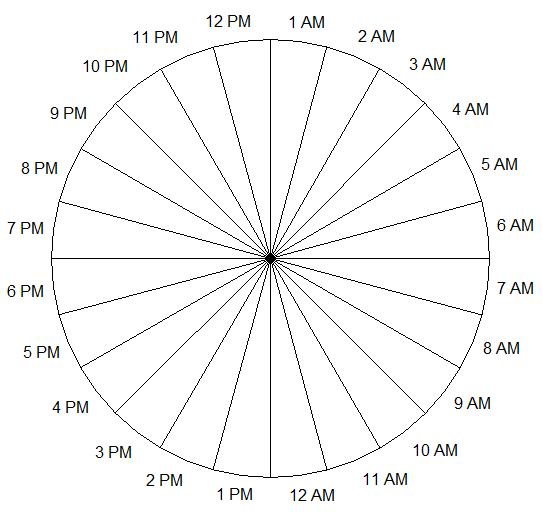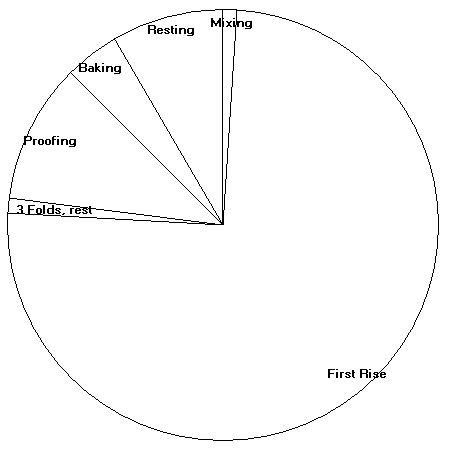I admit to being left-brained but somehow I'm still terrible when it comes to figuring out when I need to start an operation so that I end up with the bread sufficiently cooled after baking so that we can have it for lunch, dinner or whenever. So that's why I came up with my 24-hour clock graphics. Using Microsoft Excel I first created a 24-hour clock in the form of a pie diagram. See first graphic below:

I print this out on card stock so that it's a little more durable. The next figure shows a baking operation that takes ~24 hours. In this case it's one of Jim Lahey's no-knead bread operations with a long preferment followed by more standard times for folding, proofing, baking, etc.

In this pie diagram, mixing is the first operation. We now print out this second figure and cut out the circular pie diagram. With any luck it will be slightly smaller than the clock diagram so that rotating the second figure on top of the first figure will allow you to easily see all of the 24-hour clock times and determine when it's necessary to begin an operation in order to have it finished and ready to eat when you want it to. I'll be happy to send the Excel file to anyone wanting it if they send me a PM with their e-mail address. I've also included an 18-hour diagram as well.
It surprises me that some clever baker/software programmer hasn't designed such a program in Java script or some such. I can't do it but in principle it shouldn't be that difficult...
aloha,
Dave Hurd, Hilo, Hawaii
The only arguement I would have with your clock method for planning is that I don't believe it's a good idea to prepare bread based upon clock watching. The dough always communicates when the time is right for the next step and using a clock to time each phase introduces constants that are often counter-productive in bread making.
Hi, Dave.
Actually, I made a baking clock some time ago. I think FandW may have been referring to it.
David
OMG how I love that ... Use it on the cover of your next (even if it's your first) book David.
A little tidbit for new bread bakers, ;-)))) qahtan
From 'The New York Times'
A good loaf of bread cannot be rushed........
The Secret of Great Bread: Let Time Do the Work.
I'm going to have to agree with you on the time organization thing. Although I'm more of a top-down list (rather than a pie diagram) type of guy, I have something exactly like this.
For each of my breads I had an index card with the time from start to finish so that I could organize their times for efficiency. When I have to be out the door to deliver at 9:30, I can't leave at 9:45. That means everything needs to be done at 8:30 so I have time to package it up.
Good time management allows efficient use of the mixer, work bench, oven, and all of that. I think all of the interns realized the importance of this on busy mornings.
As far as 'watching the dough', of course I adjust based on 'how things look or feel', but the adjustments are minimal because I'm aware of the dough's progress each step of the way. For instance if the dough is 'getting ahead of me' as far as rising too fast between folds, I'll pull it out of the proofer to cool it down and stay on schedule.
Aloha a hui hou
-Mark
http://TheBackHomeBakery.com
I totally agree....3 months ago I followed the timing in the recipes to the T, and I got really dense and heavy bread that didn't rise well at all. Patience really pays it all. The last loaf (my Olive Bread) rose nicely because I watched the dough and not the clock. took me as much proof time as I did for the 1st rise.
Feel the Force, Luke...Feel the Force...
Aloha Mark,
Thanks for not treating me like a bread machine when all I wanted to do was suggest a general approach toward fitting bread making into some sort of approximate schedule. Maybe I should have put hash marks instead of solid lines running out from the center to the perimeter for each operation...(^-^)
aloha,
Dave Hurd, Hilo, Hawaii
Hi, Dave.
I certainly didn't mean to demean your clock. If it helps you plan your baking, it's a good thing. I'm a pragmatist.
My point is that, for the home baker, and especially the beginner, getting over-focused on time rather than on the condition of the dough leads to frequent disappointments in the quality of the product.
In the commercial environment and for those who have built proofing boxes for themselves, the added temperature control makes precise production scheduling possible. And the authors of bread cookbooks have generally worked in commercial environments, so they can focus more on time, having controlled for temperature.
I guess I should have made the point more explicit in my reply above.
Aloha!
David
Hi Dave. Notice you are in Hilo, HI. We are a Waimea (Big Island) family currently living in Indonesia. Nice to hear from home!
For someone new to bread baking, watching the dough instead of the clock is an excellent exercise. There's nothing wrong with taking notes on what times things happen at, though.
One of the issues I run into is that the temperature in the kitchen, especially in the winter, can vary by up to ten degrees. I could, obviously, get around this by making a makeshift proofer like some here have done, but instead I choose not to have schedules for breads.
However, beside the different steps in my breads I tend to write down a rough timeframe. Note that there is no guarantee that the bread would be done at this time, but it does give me a rough outline that varies 2-3 hours depending on mentioned room temperature and how happy any sourdough starter I've decided to use is that day.
Watching the dough is a given, obviously, but sometimes a bit of rough planning can't hurt either.
If you do the calculations for the desired dough temp, which factors in the room temperature, you have control over time and temperature, not the room.
This KAF [url=http://www.kingarthurflour.com/professional/dough-temperatures.html][u]explanatory link[/u][/url] is a page out of Hamelman's Bread.
I do the calculations each time I bake. It's a terrific tool for the home baker as well as the pro.
place the pointer over the center of hilo_kawika ,Dave's, clock face in his initial post. Then scroll the wheel up and down at a moderate speed. Whee!
David G
This whole discussion about whether you should watch the time, not watch the time descended into banality. Do it your own way, whatever that, is and don't worry about who disagrees with you. Float your own boat.
George
George, I apologize if you find the subject trivial. While I agree that each bread baker is free to "float (their) own boat", some who are new to bread making want to make the best bread possible and proofing (under proofing/over proofing) is critical to obtaining excellence. Because most of us have learned from experience that relying on time as a means for determining when to perform certain tasks in the bread making process, we want those who earnestly strive to achieve excellence don't become entangled in myth and, consequently, frustrated to the point of surrender.
I bake every weekend and lately I decided I need a better idea of timing. I had a few really late nights because I just didn't time things right. I do have some issues with temperature in the kitchen. It can be anywhere from 60-70F and it really makes a difference in the rise times. I think I need to make some observations about the doughs I make so I can time them correctly.
If I may suggest; find a place in your home that is free of drafts and capable of maintain a relatively stable temperature. Even in the most well constructed kitchen environments you will find drafts that can adversely affect the rise time of you bread. A simple matter of how close you place the proofing dough from a window (even the window is tightly closed) can make a big difference.
My microwave (turned off of course) has become my proofing box and it works very well.
and I appreciate the time wheel. Without good time management you are not able to pull off something like making 30 loaves of bread and a mess of sandwich rolls in a single day in a kitchen with a single oven. I created an Excel spreadsheet and worked backwards to determine when i needed to begin, and accomplished my task in 10.5 hours. There is a time and place for everything, and sometimes you just don't have the luxury of time on your side.
It seems to me that if you want your bread to be ready at an approximate time (dinner saturday night) and the formula requires multiple and lengthy steps; it is necessary to do some planning. The time wheel looks like it would be more efficient than my scribbled figuring.
Dave: I love this concept. Helps implement routine process. Does not in anyway take away from or diminish the "art" - (finger test, spiritually bonding with the dough ) of bread making.
I am interested in your spreadsheet - please explain again how to contact you with my email.
Thx / Steve